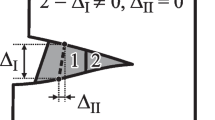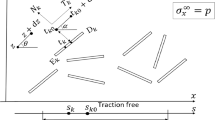Abstract
For the first time, the paper develops a method for the modeling of cracks of a new type that allows their description in environments of complex rheologies. It is based on a new universal modeling method previously published by us and used in boundary-value problems for systems of partial differential equations. The advantage of the method is the possibility of avoiding the need to solve complex boundary-value problems for systems of partial differential equations by replacing them with separate differential equations, among which the Helmholtz equations are the simplest. Namely, with the help of combinations of solutions to boundary-value problems for this equation, it is possible to describe the behavior of complex solutions of multicomponent boundary-value problems. In this paper, for the first time, the method is applied to a mixed boundary-value problem for cracks of a new type. Cracks of a new type, complementing Griffiths cracks, were discovered during the study of fractures of lithospheric plates that converge at the ends when meeting along the Conrad discontinuity. In the course of the study, Kirchhoff plates were adopted as models of lithospheric plates. The method developed in the published article is aimed at the possibility of describing models of approaching objects similar to lithospheric plates in the form of deformable plates of more complex rheologies. In particular, it can be a thermoelectroelastic plate or other rheology. In the process of solving the problems using Kirchhoff models for lithospheric plates, there is the problem of calculating some functionals that needed to be determined. This method demonstrates an approach that eliminates this drawback. The derivation of integral equations of cracks of a new type, the method of their solution, and the approach to application in more complex rheologies are given.
Similar content being viewed by others
REFERENCES
A. A. Griffith, “The phenomena of rupture and flow in solids,” Trans. R. Soc. A 221, 163–198 (1921). https://doi.org/10.1098/rsta.1921.0006
C. Sator and W. Becker, “Closed-form solutions for stress singularities at plane bi- and trimaterial functions,” Arch. Appl. Mech. 82, 643–658 (2012). https://doi.org/10.1007/s00419-011-0580-6
G. Irwin, “Fracture dynamics,” in Fracturing of Metals (American Society for Metals, Cleveland, Oh., 1948), pp. 147–166.
J. B. Leblond and J. Frelat, “Crack kinking from an interface crack with initial contact between the crack lips,” Eur. J. Mech. - A/Solids 20, 937–951 (2001). https://doi.org/10.1016/S0997-7538(01)01173-1
V. V. Loboda and A. E. Sheveleva, “Determing prefracture zones at a crack tip between two elastic orthotropic bodies,” Int. Appl. Mech. 39, 566–572 (2003). https://doi.org/10.1023/A:1025139625891
J. F. Loeber and G. C. Sih, “Transmission of anti-plane shear waves past an interface crack in dissimilar media,” Eng. Fract. Mech. 5, 699–725 (1973). https://doi.org/10.1016/0013-7944(73)90048-9
O. V. Menshykov, M. V. Menshykova, and I. A. Guz, “3-D elastodynamic contact problem for an interface crack under harmonic loading,” Eng. Fract. Mech. 80, 52–59 (2012). https://doi.org/10.1016/j.engfracmech.2010.12.010
O. V. Menshykov, M. V. Menshykova, I. A. Guz, and V. Mikucka, “2-D and 3-D contact problems for interface cracks under harmonic loading,” in Integral Methods in Science and Engineering, Ed. by C. Constanda and P. Harris (Birkhäuser, Boston, 2011), pp. 241–252. https://doi.org/10.1007/978-0-8176-8238-5_23
O. V. Menshykov, M. V. Menshykov, and I. A. Guz, “Linear interface crack under plane shear wave,” CMES— Comput. Model. Eng. Sci. 48, 107–120 (2009). https://doi.org/10.3970/cmes.2009.048.107
O. V. Menshykov, M. V. Menshykova, and I. A. Guz, “Modelling crack closure for an interface crack under harmonic loading,” Int. J. Fract. 165, 127–134 (2010). https://doi.org/10.1007/s10704-010-9492-7
O. V. Menshykov, M. V. Menshykova, and I. A. Guz, “An iterative BEM for the dynamic analysis of interface crack contact problems,” Eng. Anal. Boundary Elem. 35, 735–749 (2011). https://doi.org/10.1016/j.enganabound.2010.12.005
V. V. Mikhas’kiv and I. O. Butrak, “Stress concentration around a spheroidal crack caused by a harmonic wave incident at an arbitrary angle,” Int. Appl. Mech. 42, 61–66 (2006). https://doi.org/10.1007/s10778-006-0059-2
J. R. Rice, “Elastic fracture mechanics concepts for interfacial cracks,” J. Appl. Mech. 55, 98–103 (1988). https://doi.org/10.1115/1.3173668
Ch. Zhang and D. Gross, On Wave Propagation in Elastic Solids with Cracks (Computational Mechanics, South-Hampton, U.K., 1998).
N. F. Morozov, Mathematical Problems in the Theory of Cracks (Nauka, Moscow, 1984) [in Russian].
G. P. Cherepanov, Brittle Fracture Mechanics (Nauka, Moscow, 1974) [in Russian].
M. S. Kirugulige and H. V. Tippur, “Mixed-mode dynamic crack growth in functionally graded glass-filled epoxy,” Exp. Mech. 46, 269–281 (2006). https://doi.org/10.1007/s11340-006-5863-4
Y. Huang and H. Gao, “Intersonic crack propagation — Part II: Suddenly stopping crack,” J. Appl. Mech. 69, 76–80 (2002). https://doi.org/10.1115/1.1410936
Y. A. Antipov and A. V. Smirnov, “Subsonic propagation of a crack parallel to the boundary of a half-plane,” Math. Mech. Solids 18, 153–167 (2013). https://doi.org/10.1177/1081286512462182
G. B. Sinclair, “Stress singularities in classical elasticity — I: Removal, interpretation, and analysis,” Appl. Mech. Rev. 57, 251–298 (2004). https://doi.org/10.1115/1.1762503
G. B. Sinclair, “Stress singularities in classical elasticity — II: Asymptotic identification,” Appl. Mech. Rev. 57, 385–439 (2004). https://doi.org/10.1115/1.1767846
V. A. Babeshko, O. V. Evdokimova, and O. M. Babeshko, “On the possibility of predicting some types of earthquake by a mechanical approach,” Acta Mech. 229, 2163–2175 (2018). https://doi.org/10.1007/s00707-017-2092-0
V. A. Babeshko, O. V. Evdokimova, and O. M. Babeshko, “On a mechanical approach to the prediction of earthquakes during horizontal motion of lithospheric plates,” Acta Mech. 229, 4727–4739 (2018). https://doi.org/10.1007/s00707-018-2255-7
V. A. Babeshko, O. M. Babeshko, and O. V. Evdokimova, “A new type of cracks adding to Griffith−Irwin cracks,” Dokl. Phys. 64, 102–105 (2019). https://doi.org/10.1134/S1028335819030042
V. A. Babeshko, O. V. Evdokimova, and O. M. Babeshko, “Influence of the spatial model of lithospheric plates on an initial earthquake,” Dokl. Phys. 63, 203–207 (2018). https://doi.org/10.1134/S102833581805004X
V. A. Babeshko, O. V. Evdokimova, and O. M. Babeshko, “Fractal properties of block elements and a new universal modeling method,” Dokl. Akad. Nauk, Fiz., Tekh. Nauki 499, 30–35 (2021). https://doi.org/10.31857/S2686740021040039
V. A. Babeshko, O. V. Evdokimova, and O. M. Babeshko, “Stages of transformation of block elements,” Dokl. Phys. 61, 227–231 (2016). https://doi.org/10.1134/S1028335816050049
I. I. Vorovich and V. A. Babeshko, Dynamic Mixed Problems of Elasticity Theory for Non-Classical Domains (Nauka, Moscow, 1979) [in Russian].
B. Noble, Methods Based on the Wiener–Hopf Technique for the Solution of Partial Differential Equations (Pergamon, New York, 1958; Insotrannaya Literatura, Moscow, 1962).
Funding
Some parts of the work were completed as part of implementation of the state assignment of the Russian Ministry of Education and Science for 2022 (project no. FZEN-2020-0020), were supported by the Southern Scientific Center of the Russian Academy of Sciences (project no. 00-20-13, state registration number 122020100341-0) and by the Russian Foundation for Basic Research (project nos. 19-41-230003, 19-41-230004, and 19-48-230014).
Author information
Authors and Affiliations
Corresponding authors
Ethics declarations
The authors declare that they have no conflicts of interest.
Additional information
Translated by E. Oborin
About this article
Cite this article
Babeshko, V.A., Evdokimova, O.V. & Babeshko, O.M. On Integral Equations of Cracks of a New Type. Vestnik St.Petersb. Univ.Math. 55, 267–274 (2022). https://doi.org/10.1134/S1063454122030049
Received:
Revised:
Accepted:
Published:
Issue Date:
DOI: https://doi.org/10.1134/S1063454122030049




